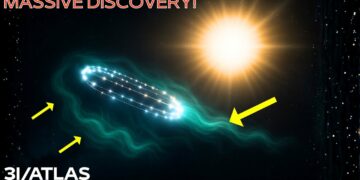Harvard astrophysicist Avi Loeb has proposed that the object known as 3I/ATLAS could be a form of alien technology. Initially, astronomers believed this interstellar visitor would merely pass by Mars. However, new data has reshaped the narrative surrounding 3I/ATLAS, first detected on July 1, 2025, and initially classified as a comet. Recent calculations from Loeb’s team at Harvard and independent analysts at NASA’s Jet Propulsion Laboratory suggest something extraordinary: this may not be a simple rock but an object potentially targeting the inner solar system.
3I/ATLAS is moving at an astonishing speed of nearly 87 km/s relative to the Sun, covering the Earth-Moon distance in under 80 minutes. Its trajectory is unusually precise, aligning closely with the orbital plane of the planets, a rarity for interstellar objects. Gravitational influences from the Sun, Jupiter, and Mars cause minute adjustments to its path, which amplify over millions of kilometers. The Mars Reconnaissance Orbiter has confirmed that the object’s coma—a hazy halo—has doubled in brightness since August, showing unusual high-energy ultraviolet spikes and CO2 outgassing rates far exceeding those of typical comets. Rather than stabilizing as it nears the Sun, 3I/ATLAS appears to be self-correcting, emitting gas plumes in rhythmic pulses every 17 minutes, resembling engineered thrusters rather than natural comet behavior.
Updated trajectory analysis indicates 3I/ATLAS will pass just 1.95 million km from Mars on September 26, 2025—a close call in astronomical terms, where Mars’ gravity could influence its path. A slight increase in velocity, as little as 10 km/s, could shift its course toward a collision with Mars, potentially within weeks. Such an impact, given its estimated 10 billion-ton mass and possible 400-meter metallic core, could release energy equivalent to 2 million megatons of TNT, creating a 60 km-wide, 5 km-deep crater. This would disrupt Mars’ surface, eject debris into orbit, and threaten spacecraft like the Mars Reconnaissance Orbiter and Perseverance Rover, crippling decades of scientific investment.
Spectroscopic data from the Gemini South telescope in Chile reveals further anomalies: the object’s tail emits nickel gas without iron, a highly unusual signature, as both elements typically appear together in cosmic material. Additionally, cyanide and CO2 levels spike sharply as it approaches the Sun, defying the predictable sublimation patterns of comets. These characteristics, combined with the object’s apparent ability to produce its own light, suggest a non-natural origin. Loeb argues that the gas emissions resemble the behavior of engineered materials under solar heat, possibly indicating an artificial structure coated in ice.
Adding to the intrigue, 3I/ATLAS originates from the Sagittarius constellation, the same region as the unexplained 1977 WOW signal. Its path through the ecliptic plane mirrors the optimized trajectories of human spacecraft like Voyager, raising speculation that it could be a deliberate probe designed to blend in as a comet. The European Space Agency’s Mars Express recently photographed three small, glinting objects in a triangular formation in Mars’ orbit, possibly scout probes ejected by 3I/ATLAS. If confirmed, these could be the first evidence of interstellar technology.
NASA is quietly preparing, with the Mars Reconnaissance Orbiter and Goldstone antennas tracking the object. Leaked data suggests radar echoes indicate a hard, metallic core, unlike typical comet ice. Loeb and his student Adam Hibbard propose that 3I/ATLAS might be a directed messenger, possibly designed to graze Mars and deposit probes or crash to release materials. Its gas pulses could be steering it like spacecraft thrusters, powered by an unknown energy source—potentially fusion or antimatter—far beyond known comet mechanics.
As 3I/ATLAS approaches perihelion in late October 2025, global observatories, including Hubble and JWST, will focus on it. Amateur astronomers report green, needle-like streams in its tail, pulsing in sync with its gas emissions and converging toward Mars. A collision could send debris into interplanetary space, potentially reaching Earth within a decade, carrying unknown materials or even nanotechnology. Space agencies, including NASA, ESA, Roscosmos, CNSA, and JAXA, have formed emergency task forces, with some insiders referencing planetary defense protocols.
This object’s behavior challenges the assumption that it’s a natural comet. Its precise trajectory, rhythmic gas pulses, and unusual composition suggest a technological origin. If it collides with Mars, the event could redefine humanity’s place in the cosmos. As it nears its closest approach to Mars on October 3, 2025, scientists are poised to capture critical data, potentially confirming whether 3I/ATLAS is a cosmic anomaly or evidence of extraterrestrial intelligence.
























